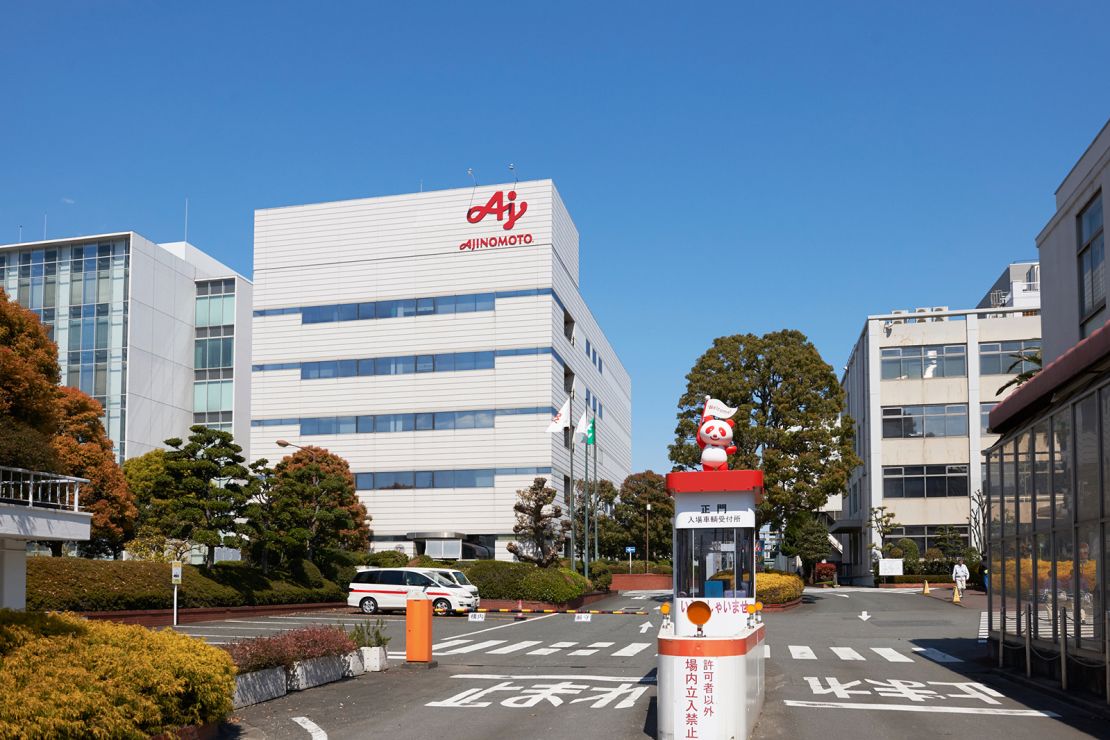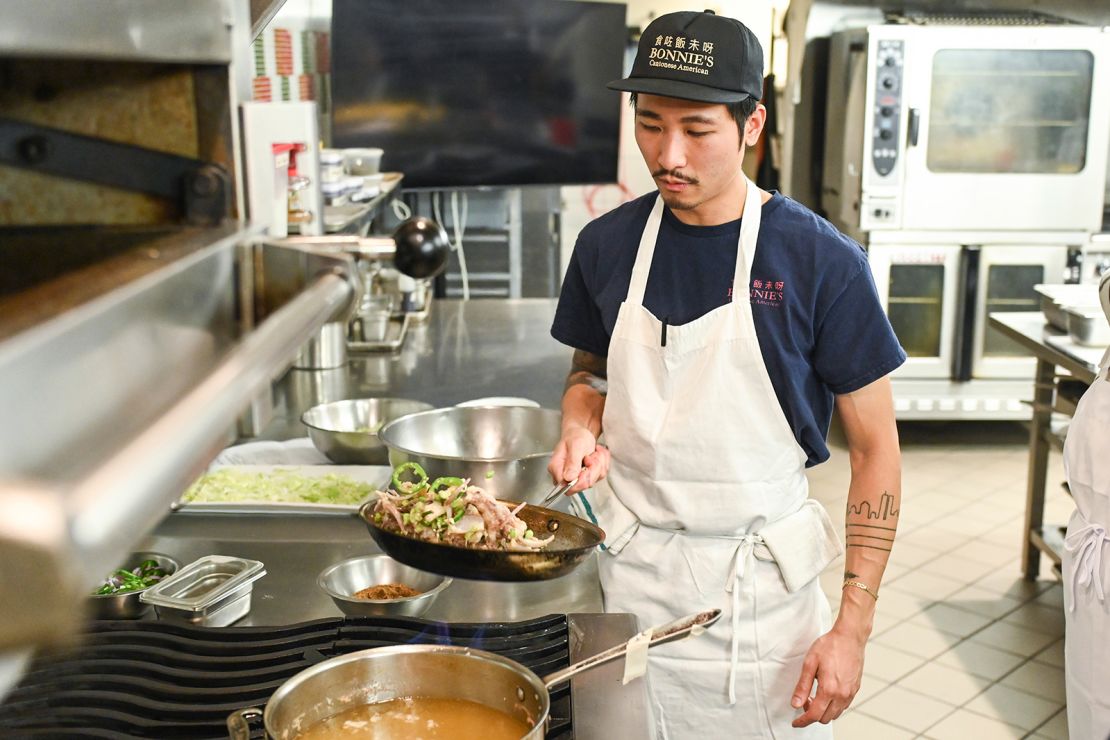CNN
—
Calvin Eng, the owner of New York-based Cantonese-American restaurant Bonnie’s, isn’t shy about his love for monosodium glutamate.
Case in point – he has the letters “MSG” tattooed on his arm, and his restaurant’s menu includes a signature drink called the MSG Martini.
“Things just taste better with MSG, whether it’s Western food or Cantonese food,” the chef tells CNN.
“We use it in drinks. We use it in desserts. We use it in savory food. It’s in almost everything. Salt, sugar and MSG – I always joke that they’re the Chinese Trinity of seasonings.”
Openly admitting to using MSG – once a surefire way to keep your restaurant empty – certainly hasn’t undermined Bonnie’s success. It’s become one of the hottest tables in New York since opening in Williamsburg, Brooklyn in late 2021, winning numerous Best New Restaurant awards from multiple media outlets.
Eng himself was named one of the best new chefs of 2022 by Food and Wine Magazine and was included on the 2023 Forbes 30 under 30 list, just to name a few of his recent achievements.
Eng is one of several celebrated chefs, including Momofuku’s David Chang and author/chef Eddie Huang, now embracing MSG and trying to destigmatize the century-old seasoning.
“Growing up, it was taboo to use MSG,” says Eng.
“My mom would never use it, but she’d use chicken powder in her cooking. As a kid, I didn’t know they were like the same thing until I was old enough to care to know about it.”
Here’s a quick recap of MSG’s history:
In 1907, Japanese chemist Kikunae Ikeda boiled down a huge amount of kombu seaweed to extract a substance – glutamate. Why? It gives certain foods, like dashi broth, a long-lasting savory flavor.
He coined the taste “umami,” then broke the substance down into MSG, which as a crystallized substance can be used like salt and sugar.
A year later, businessman Saburosuke Suzuki acquired a joint share of the MSG patent and, with Ikeda, founded the company Ajinomoto to manufacture the seasoning.
It soon became an award-winning invention and a prized condiment, especially among middle-class housewives in Japan.
In the decades to come, it became well-known around the world.
The US military even held the first-ever MSG symposium after World War II to discuss how the seasoning could be used to make tastier field rations and boost soldiers’ morale.
But MSG’s fortunes began to go downhill in 1968, when a US doctor wrote a letter to a medical journal titled “Chinese Restaurant Syndrome.”
In the document, he described symptoms like “numbness in the back of the neck,” “general weakness” and “palpitations.” He suspected MSG, along with other ingredients like cooking wine and high amounts of sodium, may have caused these symptoms.
MSG took the biggest hit, with the effects of that letter rippling on throughout the decades, all over the world.
Restaurants publicly swore off MSG. Food and beverage publicists begged not to be asked about it. Diners experiencing discomfort after a meal blamed it on MSG.

“Many didn’t know that MSG is plant-derived,” says Tia Rains, a Chicago-based nutrition scientist and Ajinomoto’s vice president of customer engagement and strategic development.
“Our process [of making MSG] is by fermentation, which is very similar to how beer is brewed or how yogurt is made.”
First, plants with sugar – like sugarcanes or corn – are fermented with microbes to create glutamate, an amino acid found in food that’s also produced in our body and acts as a neurotransmitter.
Then, sodium is added and the glutamate is crystalized to become the salt-like MSG we see in supermarkets and kitchens now.
“I’m a scientist by training. I think how MSG works is one of the coolest scientific things,” says Rains.
“We have different receptors on our tongue for different tastes. Our receptor for umami looks almost like a Venus Flytrap under a microscope,” she adds, mimicking a “C” with her hand.
“Glutamate is the amino acid that has the snug fit to that receptor.”
So what’s umami? In recent years it’s been called “the fifth taste” – joining the more familiar tastes of sweet, sour, salty and bitter – and is often described as savory.
When the glutamate goes into the receptor, it causes an umami flavor sensation on our tongue. If the food has one of the two nucleotides – inosinate and guanylate – the glutamate is able to stick to the receptor for a longer period.
“In layman’s terms, if you want to make an umami bomb, combine the glutamate – which is the core in creating umami – with one of these nucleotides (inosinate and guanylate). It’s like getting multiple hits of umami to your brain,” Rains explains.

Sounds complicated? You’ve probably been playing with glutamate, inosinate and guanylate in your own cooking without even realizing it.
Carrots and onions (high in glutamate), for example, boost the umami-ness in beef (high in inosinate). Bonito fish (inosinate) and seaweed kombu (glutamate) also combine to create a powerful umami flavor.
Foods like tomatoes and cheese even have natural glutamate in them.
“When people tell me that they ate at a Chinese food restaurant and they had trouble breathing and tightness in their chest, I get worried – and I’d say, ‘you need to follow up on that because MSG is not an allergen. It’s not going to cause an allergic response. Our bodies make glutamate, so it would not be possible to have an allergy to glutamate’,” says Rains.
Despite continued claims of negative reactions to MSG from diners, decades of scientific trials have failed to prove the existence of MSG sensitivity. Government organizations around the world have listed MSG as safe to eat. This includes the US Food and Drug Administration (FDA), which lists MSG as “generally recognized as safe” (GRAS).
“Although many people identify themselves as sensitive to MSG, in studies with such individuals given MSG or a placebo, scientists have not been able to consistently trigger reactions,” says the FDA’s website.
The Centre for Food Safety in Hong Kong notes that using MSG could reduce sodium intake, which is known for health issues like high blood pressure, heart disease and stroke.
“When used in combination with a small amount of salt during food preparation, MSG has been reported to reduce the total amount of sodium in a recipe by 20 to 40%,” said a food safety assessment carried out by a Hong Kong government scientific officer.

Yet negative opinions continue to permeate discussions on MSG, leaving the marketing team of Ajinomoto busy as it works to change attitudes.
“All these years later, we haven’t really made a dent in sodium levels in the food supply, at least in the US,” says Rains.
“We’ve got a tool to help product developers get there and we’re not using it because of a silly, outdated, xenophobic and potentially racist negativity around a food ingredient that has been consumed for over 100 years. It was too big of a challenge to walk away from.”
In 2020, the team successfully lobbied Merriam-Webster to change the definition of Chinese Restaurant Syndrome in its dictionary and has hosted symposiums to educate the public about MSG and umami.
There’s even a visitors’ center at Ajinomoto’s oldest factory, in Kawasaki, where the remaining crystals of the first-ever MSG created by Ikeda more than a century ago are proudly on display. It also showcases the history of MSG and features a diorama that explains how MSG is made.
The tour, mostly in Japanese, is open to the public and is free of charge. Visitors, usually school children, bottle their own MSG keychains and shave bonito flakes to learn more about umami.
Then they tour the 370,000-square-feet complex on a panda bus – nicknamed after the company’s mascot, Ajipanda – while smiling staff wave them goodbye from the door.

Nowadays, chefs like Eng aren’t afraid of talking about MSG and listing it on their menus, which is helping to change outdated mindsets.
“I think our clientele is a young crowd who understands MSG and isn’t afraid to consume it,” he says.
“We’re proud to embrace the use of it to help destigmatize the reputation or negative connotation that it does have.”
Health concerns aside, some diners simply view the use of MSG as a shortcut – an easy flavor enhancer. Eng disagrees with this take, noting their dishes are created the traditional way.
“We still make our stocks and broths with bones for hours. We season our food with MSG a little bit – it’s different from heating water and adding MSG and serving it with noodles,” he says.

Many of Bonnie’s dishes are classic Cantonese dishes but with playful and laborious twists.
For instance, the cha siu bkrib sandwich was inspired by two foods – the classic McDonald’s McRib sandwich and a traditional Cantonese steamed black bean and ribs dish Eng’s mother – Bonnie – loves making.
To make the sandwich, Eng steams the ribs until the bones can be easily removed from the meat. Then he marinates the deboned rib meat with a house-made charsiu sauce – made with hoisin sauce, maltose, fermented red soy curd, MSG and more – overnight.
When the meat is ready, it’s pressed and flattened out for a few hours before being glazed and roasted in the oven.
Finally, Eng places a big slab of the rib meat, onions, pickles and mustard on a Cantonese “zyu zai” bun – a classic type of soft bun bought from his mom’s favorite Cantonese bakery in Chinatown.
It’s been the hottest item on the menu since Bonnie’s opened.
“Our mission from the very beginning was to show people what Cantonese food is and what Cantonese food can be – it’s always going to be playful, fun and approachable,” says Eng.
But while opinions towards MSG may be slowly changing in the United States, the same can not be said for the rest of the world.
“Depending on where you’re at it could be very negative or very positive,” says Rains.
The expert hopes that as the reputation of MSG improves in the United States, it may influence places where MSG is still a forbidden topic.
“Negativity around MSG originated here in the United States,” says Rains.
“It wouldn’t be unreasonable to think that if we could make a dent here in the US, share the facts and have people understand the ingredient, that it may reverberate throughout the world in the future.”